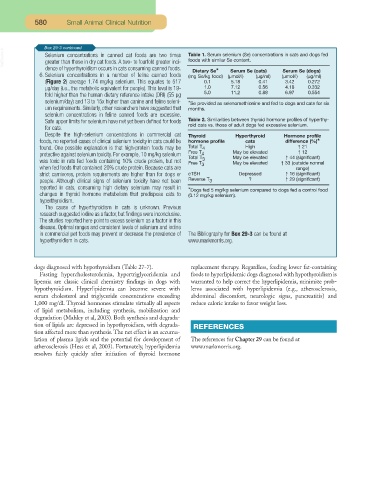Page 561 - Small Animal Clinical Nutrition 5th Edition
P. 561
580 Small Animal Clinical Nutrition
Box 29-3 continued
VetBooks.ir Selenium concentrations in canned cat foods are two times Table 1. Serum selenium (Se) concentrations in cats and dogs fed
foods with similar Se content.
greater than those in dry cat foods.A two- to fourfold greater inci-
dence of hyperthyroidism occurs in cats consuming canned foods. Dietary Se* Serum Se (cats) Serum Se (dogs)
6. Selenium concentrations in a number of feline canned foods (mg Se/kg food) (µmol/l) (µg/ml) (µmol/l) (µg/ml)
(Figure 2) average 1.74 mg/kg selenium. This equates to 517 0.1 5.18 0.41 3.42 0.272
µg/day (i.e., the metabolic equivalent for people). This level is 19- 1.0 7.12 0.56 4.18 0.332
5.0 11.2 0.88 6.97 0.554
fold higher than the human dietary reference intake (DRI) (55 µg
selenium/day) and 13 to 15x higher than canine and feline seleni- *Se provided as selenomethionine and fed to dogs and cats for six
um requirements. Similarly, other researchers have suggested that months.
selenium concentrations in feline canned foods are excessive.
Safe upper limits for selenium have not yet been defined for foods Table 2. Similarities between thyroid hormone profiles of hyperthy-
roid cats vs. those of adult dogs fed excessive selenium.
for cats.
Despite the high-selenium concentrations in commercial cat Thyroid Hyperthyroid Hormone profile
foods, no reported cases of clinical selenium toxicity in cats could be hormone profile cats difference (%)*
found. One possible explanation is that high-protein foods may be Total T 4 High ↑ 21
Free T May be elevated ↑ 12
protective against selenium toxicity. For example, 10 mg/kg selenium 4
Total T 3 May be elevated ↑ 44 (significant)
was toxic in rats fed foods containing 10% crude protein, but not Free T 3 May be elevated ↑ 33 (outside normal
when fed foods that contained 20% crude protein. Because cats are range)
strict carnivores, protein requirements are higher than for dogs or cTSH Depressed ↑ 16 (significant)
people. Although clinical signs of selenium toxicity have not been Reverse T 3 ? ↑ 29 (significant)
reported in cats, consuming high dietary selenium may result in
*Dogs fed 5 mg/kg selenium compared to dogs fed a control food
changes in thyroid hormone metabolism that predispose cats to (0.12 mg/kg selenium).
hyperthyroidism.
The cause of hyperthyroidism in cats is unknown. Previous
research suggested iodine as a factor,but findings were inconclusive.
The studies reported here point to excess selenium as a factor in this
disease. Optimal ranges and consistent levels of selenium and iodine
in commercial pet foods may prevent or decrease the prevalence of The Bibliography for Box 29-3 can be found at
hyperthyroidism in cats. www.markmorris.org.
dogs diagnosed with hypothyroidism (Table 27-7). replacement therapy. Regardless, feeding lower fat-containing
Fasting hypercholesterolemia, hypertriglyceridemia and foods to hyperlipidemic dogs diagnosed with hypothyroidism is
lipemia are classic clinical chemistry findings in dogs with warranted to help correct the hyperlipidemia, minimize prob-
hypothyroidism. Hyperlipidemia can become severe with lems associated with hyperlipidemia (e.g., atherosclerosis,
serum cholesterol and triglyceride concentrations exceeding abdominal discomfort, neurologic signs, pancreatitis) and
1,000 mg/dl. Thyroid hormones stimulate virtually all aspects reduce caloric intake to favor weight loss.
of lipid metabolism, including synthesis, mobilization and
degradation (Mahley et al, 2003). Both synthesis and degrada-
tion of lipids are depressed in hypothyroidism, with degrada- REFERENCES
tion affected more than synthesis.The net effect is an accumu-
lation of plasma lipids and the potential for development of The references for Chapter 29 can be found at
atherosclerosis (Hess et al, 2003). Fortunately, hyperlipidemia www.markmorris.org.
resolves fairly quickly after initiation of thyroid hormone

